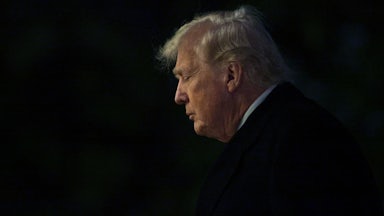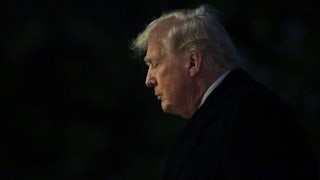Economists like to criticize irrational fears in others, but state out loud the phrase “wage-price spiral,” and they’ll act as though you just drew a cartoon blaspheming the Prophet Muhammed or shouted “Fire!” in a crowded theater.
Let me stipulate that I would never draw a rude cartoon of the Prophet Muhammed, nor shout “Fire!” in a crowded indoor venue (unless, of course, the place were really on fire). I don’t wish to insult people about their religion—also, I can’t draw—nor do I wish to create public panic that could result in injury.
But if you happen to be an economist, here’s your trigger warning: I’m going to repeat throughout this article the phrase “wage-price spiral.” A wage-price spiral is an upward corkscrew in which higher wages push up prices, prompting workers to demand even higher wages, and so on.
On February 10, the Bureau of Labor Statistics reported that inflation in January rose 7.5 percent over the previous 12 months. Is the economy entering a wage-price spiral? I think not, mainly because the wage half won’t likely cooperate. More on that in a moment. But I dispute the notion that saying “wage-price spiral” out loud risks conjuring one into existence, any more than saying “Lord Voldemort” will summon the Dark Lord of the Harry Potter books and movies to my home office.
Robert Shiller, a Nobel laureate in economics who teaches at Yale, wrote last week in The New York Times that wage-price spirals are a sort of Bigfoot, a mythical beast that the public, unaccountably, claims to have glimpsed at periodic intervals in history. He cited an early mention from an 1868 book titled The World’s Crisis by a newspaper editor named L.B. Woodfolk:
Employers find their expenses increased by the inflation of prices and the high rates of labor, and set on foot combinations to effect another rise of prices. The advance, again, causes the laboring population to demand a commensurate rise of wages; and so the ball rolls on.
To Shiller, this, and subsequent examples he found in two news clippings from the Times in 1937 and 1971, constituted inappropriate moralizing. “The public tends to think of inflation as an indicator of a cycle of greed and inhumanity,” Shiller wrote, when in fact inflation “is more technical, like an increase in the money supply or disruptions in the supply chain.” Talk of wage-price spirals, he suggested, is so much dangerous nonsense.
But even granting that the current inflation spike was created by disruptions in the supply chain combined perhaps with low interest rates and generous Covid-related aid—even granting all that, it ought not be considered ridiculous to ask whether we will experience a wage and price spiral. Yet one is not permitted to ask. It isn’t just Shiller. In The Wall Street Journal, Judge Glock, director of policy and research at the “market-driven” Cicero Institute, wrote on January 31 that “the wage-price spiral is a false and antiquated economic idea that refuses to die.”
I’m sorry, but this is insane. If wage-price spirals don’t exist, what exactly did we experience during the Great Inflation of the 1970s? The standard answer, even among most economists, is that after an initial burst of oil shocks we experienced a wage-price spiral. But acknowledge today that they do exist, and terrible things will happen. Shiller again:
Once lawmakers, business leaders and consumers come to believe the spiral has really taken hold, that belief can amplify long-term inflation expectations. It can make people angry and rigid in their demands.
Say wage-price spirals can occur, and they will occur, even though … they don’t exist.
I think it’s time we took a fresh approach.
Of course wage-price spirals exist. The appropriate question is whether we’re likely to experience one now. The most plausible answer is that we won’t.
For a wage-price spiral to occur, price increases have to alternate with wage increases, each side trying its best to keep ahead of the other. For that to happen, corporations must have sufficient market power to raise prices. Rising economic concentration since the 1970s makes that part more than possible. But labor must also have sufficient market power to raise wages. And anyone who’s been paying attention for the past four decades knows that the decline of labor unions and the enthronement of share prices as the be-all and end-all of capitalism makes any sustained effort by workers to boost their wages pretty unlikely. Even during the Great Inflation, the wage half of the wage-price spiral couldn’t and didn’t quite keep up, because the collective strength of organized labor was already on the wane. Workers have much less leverage today. Union membership within the private sector was 24.2 percent in 1973, when the Arab oil embargo triggered the Great Inflation. Today it’s 6.1 percent.
Yes, wages have been rising during Covid-19, and the 2.9 percent “quits” rate is described as a Great Resignation. But much of that Great Resignation is really just the Great Early Retirement, brought on by workers in their fifties seeing their retirement accounts fatten and deciding to call it a day. And the quits are concentrated heavily in retail and food services—which is to say among mostly nonunion, lower-wage workers, many of whom are relatively easy to replace with automation. Raise your hand if you’ve checked yourself out recently at the local supermarket.
According to the Atlanta Fed Wage Tracker, the biggest wage gains over the past few months have occurred among lower-skilled workers. On Twitter, Harvard economist Jason Furman posted the following chart showing wage growth, corrected for inflation, since 2019, broken down by occupation:

This, too, shows gains during the Covid pandemic in low-wage sectors like leisure and hospitality and retail—and losses just about everywhere else. “No question one would like to see real wages rising across the board,” tweeted Chuck Marr, director of federal tax policy at the nonprofit Center for Budget and Policy Priorities, in reply, “but if one had to choose just two sectors, these are good ones. Strongest real wage growth for what I think is a combined group of about 25 million people who work for relatively low pay.” (A caveat that Georgetown economist Harry Holzer pointed out to me is that nominal wage increases for other workers are a not-unhealthy 4 to 5 percent.)
Will the lowest-paid Americans drive a wage-price spiral? We should be so lucky. But no, that doesn’t look likely. As Josh Bivens of the Economic Policy Institute observed last week, “Relative to the situation in the 1970s, the 2021 inflationary shock is playing out in a context of highly unbalanced bargaining power between labor and capital.” Bivens noted that Treasury Secretary Janet Yellen and Fed Chairman Jerome Powell both said recently that they saw no evidence of a wage-price spiral emerging. That sounded dangerously as though they believe wage-price spirals do exist. And indeed, the Fed will be raising interest rates over the next year. There’s some danger it will do so more than necessary to keep inflation in check. But if that happens, it won’t be because they spoke the forbidden words.










